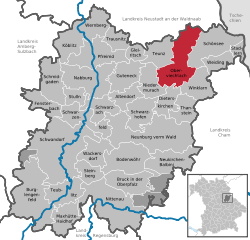Oberviechtach
From Wikipedia, the free encyclopedia
| Oberviechtach | ||
|---|---|---|
| ||
 Oberviechtach | ||
Location of Oberviechtach within Schwandorf district  | ||
| Coordinates: 49°28′N 12°25′E / 49.467°N 12.417°ECoordinates: 49°28′N 12°25′E / 49.467°N 12.417°E | ||
| Country | Germany | |
| State | Bavaria | |
| Admin. region | Oberpfalz | |
| District | Schwandorf | |
| Government | ||
| • Mayor | Heinz Weigl (Parteilose Wählergruppe) | |
| Area | ||
| • Total | 62.41 km2 (24.10 sq mi) | |
| Elevation | 507 m (1,663 ft) | |
| Population (2012-12-31)[1] | ||
| • Total | 4,941 | |
| • Density | 79/km2 (210/sq mi) | |
| Time zone | CET/CEST (UTC+1/+2) | |
| Postal codes | 92526 | |
| Dialling codes | 0 96 71 | |
| Vehicle registration | SAD | |
| Website | www.oberviechtach.de | |
 Oberviechtach (German pronunciation: [oːbɐˈfiːçtax]) is a town in the district of Schwandorf, in Bavaria, Germany. It is situated 31 km southeast of Weiden in der Oberpfalz, and 27 km northeast of Schwandorf.
It is famous for being the birthplace of Johann Andreas Eisenbarth. The name comes from pine (Fichte) which is also represented on the coat of arms of the town.
Oberviechtach (German pronunciation: [oːbɐˈfiːçtax]) is a town in the district of Schwandorf, in Bavaria, Germany. It is situated 31 km southeast of Weiden in der Oberpfalz, and 27 km northeast of Schwandorf.
It is famous for being the birthplace of Johann Andreas Eisenbarth. The name comes from pine (Fichte) which is also represented on the coat of arms of the town.
Oberviechtach was chartered in 1337.[2]
References
- ↑ "Fortschreibung des Bevölkerungsstandes". Bayerisches Landesamt für Statistik und Datenverarbeitung (in German). 31 December 2012.
- ↑ Columbia-Lippincott Gazeteer. 1952 Edition. p. 1362.
This article is issued from Wikipedia. The text is available under the Creative Commons Attribution/Share Alike; additional terms may apply for the media files.
